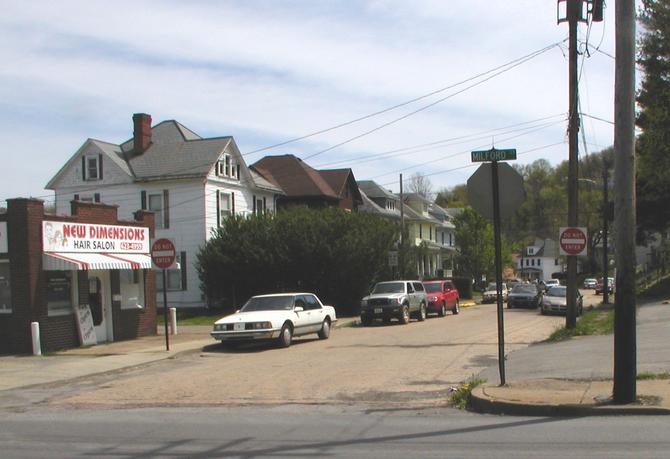
| Next Chapter | Previous Chapter | |
| Chapter 60: The Spankin Room | Contents | Chapter 58: Short Short Stories About Farmers |
As you get older your mind retains connections from your entire life. You look at things and get connections a young person or stranger misses entirely. I want to show young people how this affects a trip along a local highway for me. Lets start at the bridge over the West Fork River in West End of Clarksburg and go out toward Jane Lew.
On the end of the bridge toward town is the old West End Feed Store, where Dad bought feed for the dairy he ran when I was a kid. Many times when I was a child I have taken trips with him to pick up feed there. I can still see the dark recesses of the building and remember the molasses smell which was an important ingredient of the feed, improving palatability. Now it has been put to another use entirely. On across the bridge now we come to what was once a fairground. The old racetrack is now Park Boulevard. I can remember vividly Grandfather Kennedy telling about going to fairs there and watching horse races.
The old streetcar that ran from Weston to Clarksburg came down this street, Milford Street, and across the bridge. The cut which allowed it to come from the steep hillside on toward Lost Creek and Weston into Milford street is still there, on the left as we go out. The area near the intersection of Milford Street and North Avenue was a more important shopping district in the past when cars were not so common, when people walked for groceries and before local grocery stores were replaced by supermarkets.
Stealey was a pretty respectable residential area of Clarksburg when I was a child. The Stout family to which I was related through Grandmother Kennedy, and who owned the farm adjacent to ours at Lost Creek, mentioned above in connection with Mr. Mick and his family, lived near the point where the street car track left Milford Street. John Pierpoint, who was the County Extension Agent, when I was a kid, lived in a pretty little house on the left further out, and the Israel family, friends of Aunt Lotta, with
(Illustration 59-1)

This street was once a racetrack on the fairgrounds
two old maid teachers in the family and one son who married late in life, lived off somewhere to the right. (See the next Aside . The story is about this man . )
The next landmark for me is Oscar Andre’s house. It lies in the turn of the road on the left as one starts down Milford Street to the river. It is an absolutely flawless Dutch Provincial, now yellow. Nan Andre Hatton, Oscar’s daughter, informs me that it was built in 1940 by her parents. It had the first all electric kitchen (with dishwasher and garbage disposal) in Clarksburg.
(Illustration 59-2)
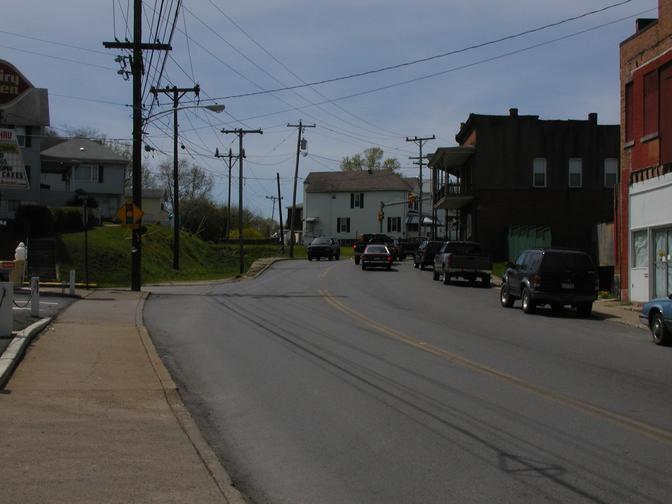
The “street car” (trolley) left Stealey on the way to Lost Creek and Weston through a cut to the left of the white house in the center of this picture
Oscar was a Belgian American, a descendant of the Belgians who came over to make glass in Salem around the turn of the century. He worked in the glass factory eight hours in awful heat, went to college and made excellent grades, and played athletics, all at the same time. He became a lawyer, working for Steptoe and Johnson, and was a friend of Dad’s, who had him do legal work until Oscar got too busy with larger accounts. His name was well known in our house as I grew up. In 1977 I still taught at Salem and my brother-in-law, Dallas Bailey, was President. He asked me to give the Presentation for Oscar’s Honorary Doctorate given by Salem that year. I praised Oscar highly, and said his name was a household word in our house. Some years later, searching the records in the Harrison County Courthouse I found he had held a mortgage on the farm for a many years! I’m sure it was charity. We kids never knew! I was about as embarrassed as ever in my life when I found out.
(Illustration 59-3)
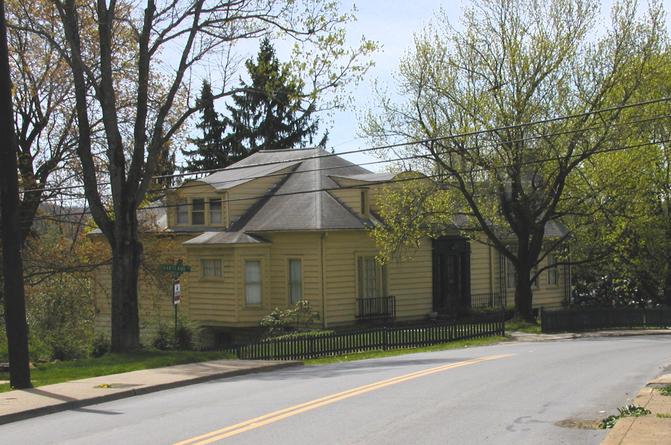
Oscar Andre’s house
Town ended where the bridge over to the Veteran’s hospital now stands. There were beautiful farms along both sides of the road. The Gore family owned a particularly desirable tract where Rosebud Plaza now stands and another up Davisson Run starting where the Allen Building now stands and extending through to Rt. 50 along Sun Valley.
A little further south along Rt. 19, Sunny Croft Country Club was a new comer after World War II, the older Country Club being preferred by highly social Clarksburg people “with money.” The road to the Country Club was (and still is) about a half mile beyond, on the left. Appropriately, the Harrison County “Poor House,” as it was called by people I knew, stood across from the southern end of the Sunny Croft property. This institution was a large, ornate red brick building where the destitute could retire if they had no means at the end of life. I always found its proximity to the country clubs an interesting contrast. It went out of use about the time Sunny Croft was founded, but stood on that location until the Country Club Dodge dealership bought the land and demolished it.
At the top of the second hill after is Locust Heights, a development built on an old strip job. It is the sight of a small but excellent machine shop run by Keith Woodruff. My Uncle Gene recommended the machine shop to me many years ago. I have had most of the farm’s machine shop work done there for many years. Mr. Woodruff owned and ran an old fashioned steam driven saw mill there once a week for many years. Men came from miles around to enjoy seeing it work. My friend Worthy Hall, who lives at Lost Creek, spends many happy evenings there.
Halfway down the hill, is the entrance to what was the Skyline Drive-In Theater. Happy hours were spent there with friends during and after high school. One night when I was a senior, I was allowed to take the family car and to take some friends to the drive-in. There were eight of us, four in the front seat and four in the back. On the way out the girls in the front seat beside me made such a show of waving to friends in a car coming in, that I couldn’t see, and drove over a sign that directed the incoming traffic to the right. Fortunately, the sign was constructed for that eventuality, and no harm was done. You wouldn’t believe it now, but the hill around the Skyline was mowed with 8-N Ford tractors and pastured many years after the theater was built. Actually, the final growth of trees which led to the forest you see now began only after the theater became an economic casualty.
(Illustration 59-4)
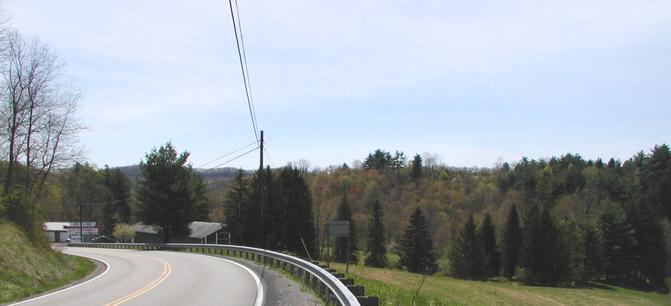
Site of former Skyline Drive-In Theater. Entrance to the left, and the drive-in itself was on a strip job, the flat area in the right rear .
A mile further on is the point where Rt.19 comes to the edge of the West Fork River. Here there was an old bridge referred to as the “ Laurel Park Bridge.” It went across to a narrow peninsula of land, behind which a large area of river bottom opens up reaching to West Milford in one direction and by a dirt road to Mount Clare in another. I remember getting stuck in the mud on the Mount Clare road, right along the river. I walked back a mile or so to the first house with a tractor to ask the man for a pull. He wanted to know who I was. I told him I was Tom Bond. “Well, I once knew a Tom Bond,” he replied, “He lived over between West Milford and Lost Creek.” “Why that was my grandfather,” I told him. He pulled me out and wouldn’t take a cent.
Just across the Laurel Park Bridge, on the left, was a venerable establishment known as Laurel Park, a place which had for years maintained a bath house and picnic ground. I remember going there once as a child for a church function. It was silting in badly then, and the pool in the river now is entirely gone. There has been no Laurel Park for forty years.
(Illustration 59-5)
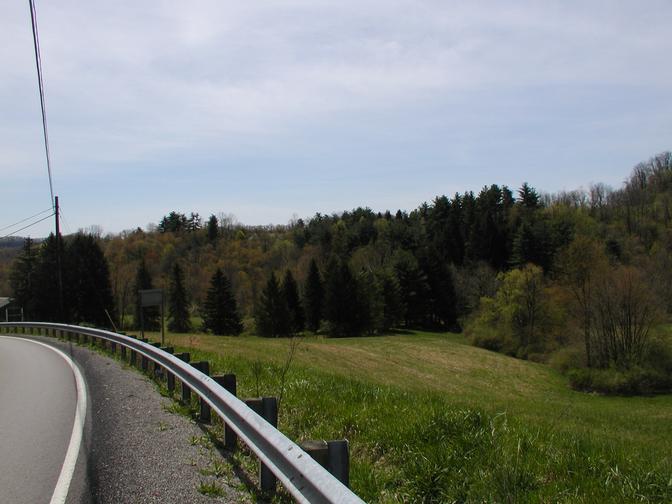
Skyline Drive-In again. The level of the strip job is now obscured by trees, except in the left center rear. This hill was kept in grass by mowing with 8N Ford Tractors until long after the author was an adult.
Just south of this along Rt. 19 was the Johnson Farm, owned by sometime Secretary of Defense Louis Johnson. It was a splendid piece of ground, with a fine old brick farmhouse that went back to Civil War days. When I was in high school it was operated by a man named Anderson. His daughter, Janet Anderson, was my date for the Senior Prom. Janet was my sister Lou’s friend. Today the farm is owned by Jimmy Allen, who has developed part of it with apartments, put a public stable on part of it, and has generally let the rest of it run down.
At the other end of the Johnson Farm is Sycamore Dell and Sycamore Road, which has been the shortcut from the Lost Creek farm to Salem for generations of our family. About 1948 at this intersection Nellie Jo Bond, daughter of Harley and Marcella Bond, now Mrs. Richard Brissy, failed to make the turn. She was coming from West Milford, on the way to Salem, and she was just learning to drive. When the car stopped it was at such an angle that it almost fell over backwards. Nellie Jo and her mother were in the front seat and her father and Reva Sterns were in the back. Reva was the fiancée of Nellie Jo’s brother, Dick. As a result of the angle, Reva’s dress scooted up to show an unseemly amount of thigh. As Nellie Jo tells the story, Harley first reached over and pulled Riva’s dress in place and then announced, “We must all remain calm.”
At one time the brick road from Clarksburg ran out to this point, and this is where Dad and his “Independent” basketball teammates met the bus when they traveled, around 1930. There was a small town here once, but it was gone before I can remember.
Half a mile further on, at what is now the entrance to S & S Landfill, is a turn I remember going around with a bunch of boys at the humongus speed of 65 miles per hour in a car driven by Bob Kennedy before I learned to drive. I didn’t tell that story at home, either.
On down the road is the (now) Huffman Farm. One of my father’s great regrets is that he didn’t buy that farm when he had the chance. He and Grandfather Kennedy considered it at a price of $10,000. They weren’t sure they could pay for it in the conditions that prevailed during WWII. The depression lasted through and after WWII for farmers. It was over for laborers as soon as the demand for labor became great. It was over for money lenders before that! Within ten years, after they could have bought it for $10,000, the royalty for coal mined on that farm exceeded $75,000. That was big money in those days.
The top of the hill after the Huffman farm is known as Kirby Hill. It was once a filling station. Before the Kirbys it was known as Hough Hill, and they also had a filling station. This is where I remember the old style gasoline pump where you tell the attendant how much you want and he works a lever back and forth to fill a glass cylinder over head marked at each gallon level. When the gas is at the right number of gallons he would stop, and use a hose to discharge it into your tank. None of this “Ten dollars worth please!” that we do now, and there was always change to make. Of course, it was only about twenty-five cents a gallon!
Just before the location of the old filling station on the right is an inconspicuous road on the left where an immense amount of coal came out on the public road. All the coal from the Huffman farm, mentioned in the previous paragraph, and a great deal more (at a nickel to ten cents a ton royalty) came on the road here. Just beyond the location of the old filling station on the left is another road which delivered a comparable amount of coal. It is up this road I had my experience on the coal auger, detailed above.
At the bottom of the hill on the right is the Dairy King. In the house behind it is where my first grade teacher, Miss Sidebottom, went to live after she was married. Beyond is a little straight and at the end of the straight is a convenience store that is relatively new. Just beyond it is a garage. There has been a garage there since long before I can remember. When I first began to farm on my own, the garage was run by Troy Bartlett. He had purchased it in a run down state and revived and rebuilt it. He was primarily a welder, trained in the repair of stripping equipment but quite versatile. His son is the young man mentioned in the story about Boy Scouts “stealing sheep” told above.
Long before Troy, the garage was run by Allison Bartlett, a self-taught genius of a mechanic of the type that sprang up when machinery was new. This is just at the early limit of my memory. To support the claim he was a home grown genius, I can remember only a few things. He made a lot of the parts he used. He welded two shotgun barrels together to get a smaller shot pattern, and the gun could be fired. He also made such things as a homemade tractor. In those days greasy parts were always washed in gasoline. Allison kept a five gallon bucket with about a gallon of gasoline and a rag in it on one side of the garage. Being an inquisitive kid I looked into it one time and saw half a dozen cigarette butts. I asked Dad about this when we got home. He said it was a common practice in garages to flip cigarette butts into the parts washing bucket. I knew about the flammability of gasoline and had probably seen it used to start fires by that time. Dad further explained that in passing through the air the flame in the outer part of the cigarette was extinguished, and it seldom caught the gasoline on fire. Note the italics for emphasis.
Just beyond on the other side of the road is the house my high school friend Joe Kennedy lived in, with
(Illustration 59-6)
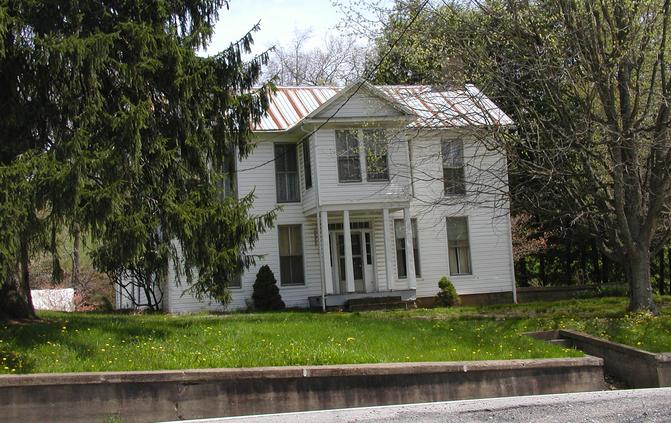
The house where the two Kennedy boys, Joe and Bob, my cousins, lived
his older brother Bob and the rest of their family. Joe was the underage truck driver who had to outrun the union men, Bob the driver going sixty-five around the turn above. Both boys became engineers and Joe now lives in British Columbia, Bob at Philippi, WV.
Further out is the exit to West Milford, and another series of stories, because I went to twelve years of school there. The great old building, with its oiled floors is no more, except in a few pictures and the memory of its sometime inhabitants. Because of the pine construction and the oiled floors we had several fire drills a year. The great fire came after the building was abandoned, however, possibly the result of vandalism.
In the turn of the road beyond the turn up to West Milford once stood a small house, in which Mrs. Fowler, the school cook and friend of my Aunt Lotta, who was the Home Economics teacher. She was an intelligent lady in reversed circumstances. Her son Ron is my friend to this day. He was educated as a forester and is now an executive in the West Virginia Farm Bureau, and runs a tree farm.
Beyond is Buffalo Creek, once fine farming area. It is now given over to storage of water and recreation, and has some nice smaller farms, but is much grown over on the upper end .
Just beyond, what was Garrett Snyder’s filling station (now Evans Service Center) is along the river. Much invaluable aid came to my mother from this station in her older years, and I believe my sister Ann and her husband Dallas still trade there. Across the river is a settlement that was not there in my youth. It was a fine farm then belonging to George Strother with a beautiful house set perhaps a quarter mile back from the Duck Creek Road. A fine stand of short needle pines ran along the side next to Duck Creek. “Flagstone” walks were very popular in my youth. Mr. Strother had the largest flagstones I have ever seen at the base of the steps leading to his house, at least six feet on a side. It must have been quite a job to move them, even with horses.
Going beyond the filling station along the river and up the hill, stands a little house I have always admired. It is like something from a story book. Beyond it is a fruit stand that once belonged to “Soupie” Ayers, who played football with Dad at Salem College. Dad took me out there when I was in junior high to show me off. I didn’t live up to his expectations in the football category, though.
Over a few humps and on the left is the house my high school friend Gilbert Sumners lived in, next door to his mother’s folks. He is now in Alaska, having spent his working life employed by the telephone company there. I heard recently he is now a tour guide. We have corresponded on the internet in the last few years.
At the bottom of the hill on the left where Rt. 19 goes back down to the river is the Strawberry Farm, where they had pick it yourself strawberries for several years. They used good technology – it was weeded by geese, rather than by hand. Across from this is the old Shelt Workman dairy, which was a hard scrabble dairy in my high school years.
Right in the bend of the river, on the right, is a house that was lived in for several years by Glenn Riddle, my Vo-Ag teacher. Certainly one of the best teachers I ever had. Several of my teachers were pretty bright people, fortunately.
A little further on is Good Hope community. It was always a small residential town, with a store or two and a school. About half the graduates from Unidis High School went to grade school there. They joined with the pupils of West Milford Grade School for the seventh grade. West Milford Grade School was on the first floor of the building in West Milford, with Unidis High School on the second floor, and there were two auxiliary buildings – Vo-Ag and Gym.
They told a story at the Good Hope Grade School about Zell Coffindaffer, who was the sixth grade teacher and principal. He would spit his tobacco juice out the classroom window, and sometimes some of it would blow back in on the kids. Sounds pretty bad today, but chewing was common even among educated men, and there always was the disposal problem. The Coffindaffers were a huge band of the sturdy type who settled in West Virginia. They lived primarily on Kinchelo Creek for many years and owned a considerable part of that watershed. Some of the descendants are still around. The Burnside
(Illustration 59-7)
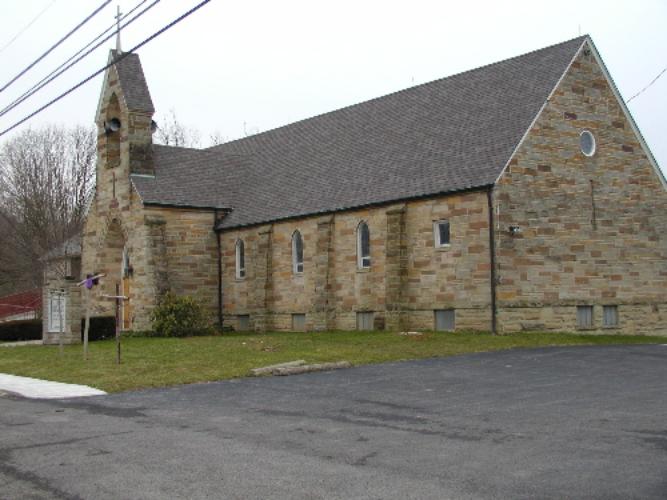
New Bethel United Methodist Church
family was another extended clan from the area. I have known many of both families.
About a mile beyond Good Hope, on the bank of the West Fork, is the New Bethel United Methodist Church, an ancient and venerable rural community institution. Its congregation has served the community for a long, long time.
Across the river is an unpaved road on the left that runs back to Duck Creek. Jim Washburn had a fruit stand in the corner for many years. Jim was an intelligent but very eccentric member of the community. He was the one that proposed the name “Concerned Land and Natural Resources Owners” for CLANRO. They had a little farm back toward Duck Creek, and Jim was hard pressed to make a living from its limited resources. His son, Terry, is a long time Vo-Ag teacher at Lewis County High School, and the last I heard, still lives on the family farm. Lehman Maxwell’s cattle drive came off 19 here, too.
Across the road, a hundred yards toward Jane Lew on the right, is a building which was once Chicken Inn. Our family was too poor to eat out often, but when we were young Dad took us there to have the experience of eating in a restaurant. My sister Ann, remembers going there for mother’s birthday.
Diagonally across from that is a building that once was Harve Beeghley’s garage. My father had a lot of work done in his garage over the years. I remember going there to get the brakes on the second Ford 8N tractor repaired before going up above the high wall on the strip job to “cut filth.” By the time the “filth cuttin’” was done, the brakes would be starting to slip again. (No recalls in those days!)
(Illustration 59-8)
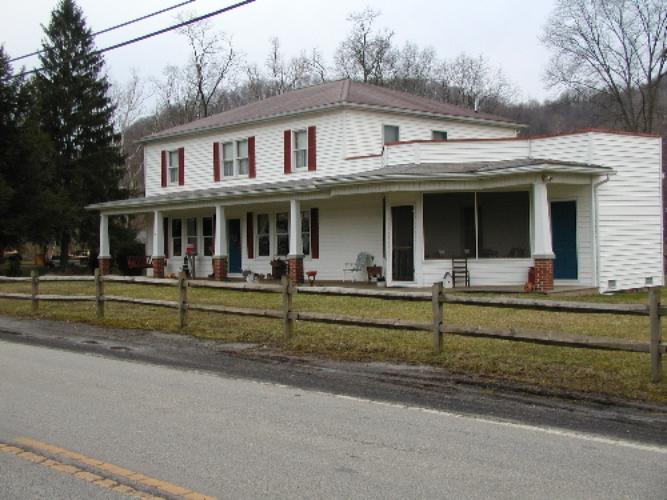
Formerly “Chicken Inn”
Beyond is the home of Virginia Smith, my fifth grade teacher. I disliked her as much as any teacher I ever had. She was a divorcee, living at home with her parents. Some of the girls liked her – she had a very strong personality, but most of us were simply afraid of her. Instead of paddling like most teachers, she made us “sit on the wall.” She took the offending student into the “cloak room.” This was before lockers in the hall. It was a large closet with clothes hooks for each pupil, and it was within hearing, but not sight, of the class). There she made the one being punished assume a sitting position, as in a chair, back against the wall with feet out in front. The muscles in the front of the thigh could supply enough force to hold the position for a few minutes, but then began to give away. The kid sat there with aching, trembling muscles, afraid of falling down until she gave relief, which came at her pleasure, often not soon. She seemed to enjoy this part of her work. It came with smiles and threats at the same time.
A mile beyond Chicken Inn on the right is the Two Lick Bridge, a road leading where many of my friends have lived. A mile beyond that is the “Old Plantation Inn,” the first place I ever took a girl for a meal. She was Judy Hardesty, daughter of Captain Hardesty, a Reserve Officer and a man of comfortable means who lived near the old Washington-Irving High School in Clarksburg. Her mother was very, very nice. Judy later attended Ohio Wesleyan and married an engineer.
Another mile and a half beyond is the Gooseman Bridge, which leads to the Kinchelo area and the back side of Jane Lew, Jackson’s Mill, and Weston. Across the bridge is the farm of Paul Nay, long time Farm Bureau official, outstanding farmer and a quiet genius. There was a quiz program on the radio at one time that pitted farmers from one part of the country and another against each other. Winners continued to the next week. Paul was on the show for months. The farm has always been outstanding in my time.
The next farm beyond Gooseman Bridge is owned by the Allman family. Dottie was in my class in High school, David was a couple of years older, and later this farm belonged to their older brother Bill. In high school their father owned a farm on Two Lick. They were one of the four families who sold “Golden Ayreshire” milk that out lasted the other local retail diaries. When that fell through, Bill Allman set up a dairy to sell milk by the gallon, ice cream, cottage cheese and related products on the farm near Gooseman bridge. It seemed to be going on well, but when Bill figured the cost of producing the milk, he was losing about dollar and fifty four cents a gallon.
The higher ground around the old dairy store is now in crops, and most of the valley of Hackers Creek from that point up to the “Iron Bridge” where Rt. 19 crosses Hackers Creek is owned by Bill’s son, Tim, who uses it for pasture.
Just across the Iron Bridge on the left, up an unpaved road is a farm once owned by a Mr. Barron. He set up his son Joe in the welding business. Joe Barron has done a lot of welding for individuals and for coal companies. He also sells firearms. Joe had a very famous accident once while welding on a coal truck. Electrical welding uses a large direct current, which heats the welding rod hot enough to melt it, and surface tension draws the molten metal into the crack where it cools and welds the parts together. Of course, you have the rod on one cable and the other cable is hooked to the work piece to make a circuit. Somehow Joe got the second cable hooked in the wrong place. The current went through the drive train of the truck and in addition to welding where he wanted to, the current welded all of the moving parts of the drive train together. The truck owner wasn’t happy. The insurance company wasn’t happy. And Joe wasn’t happy, either! Anybody can make a mistake, but not all of us have the opportunity to make such a big one!
Just beyond this is the “Jane Lew straight,” which, before the interstate, was the place where young guys liked to take their vehicles up to the top speed. It was one of the few places where this could be done before interstate. I have long admired the low stucco house on the left on the bridge end of the straight. It is an admirable farm house, which looks almost Australian, low and broad, but is now badly grown up. The land along the south side of the straight was once quite grown up, in part because it is low and much of it swampy. The sewage treatment plant, the well drilling company, Weston Transfer, the Armory and the rest are quite new. On the upper, Jane Lew, end were a couple of old farms that did not see much farm use in my lifetime.
Jackson Heights must have been a great farming area at one time, but had been developed along the road before I can remember. I have seen it pushed back to the right especially in the 80s and 90s. Shortly after this we cross the location of the old streetcar tracks.
At the intersection of the road to Lost Creek is a spot that has for a very long time been dedicated to enjoyment of alcohol. The first establishment I remember was the “High Jane.” It seems to me that there was a great deal more public drunkenness and attendant rowdiness when I was a kid. This may have been a result of the rough work and low pay prevalent then, especially in the mines. Alcohol was the only drug available; even marijuana was not available in rural West Virginia. Anyway, there was a state policeman at the High Jane most of the time. More recently it was called the Gold Coach and now the Jane Lew Junction is in the same building. There is a second establishment, the Lazy J, side-by-side at that location.
(Illustration59-9)
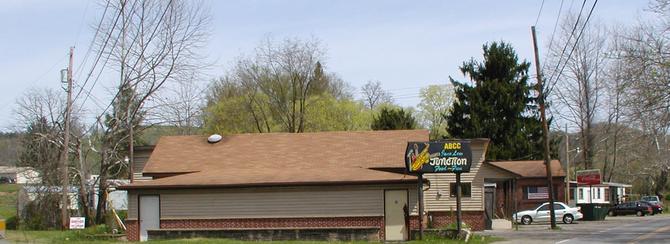
Jane Lew Junction
Next you pass under the old railroad trestle, which was not removed when the train track was taken up ten years or so ago. Near the top of the grade beyond is the site of the Jane Lew School. In my youth it was another twelve year school but it is now replaced by a grade school which feeds its graduates to Lewis County Junior High at Weston. The glory of the old Jane Lew High School was its excellent gymnasium, far the best gym of any of the small high schools anywhere around in those days. The gym was kept several years after the local school was changed to a grade school. On the right is a log house, restored many years ago by Joe Lightburn, III, and others. My friend Mike Kelly lived there as a boy.
On down the street is the Methodist Church, to be commended on keeping its nice new addition architecturally consistent with its original style. Most institutions which build additions go for the least
Illustration 59-10)
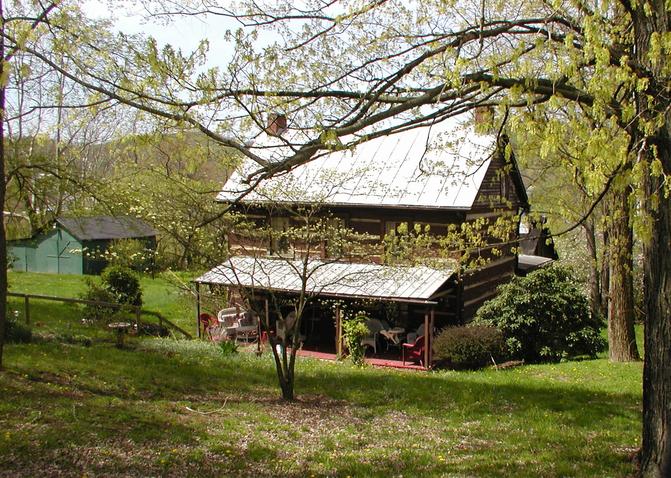
expensive or the most modern looking additions. Beyond, across the street is the residence of Joe Lightburn IV and his sister Frances, and formerly, his father Joseph B. Lightburn III and his wife Susan.
(Illustration 59-11)
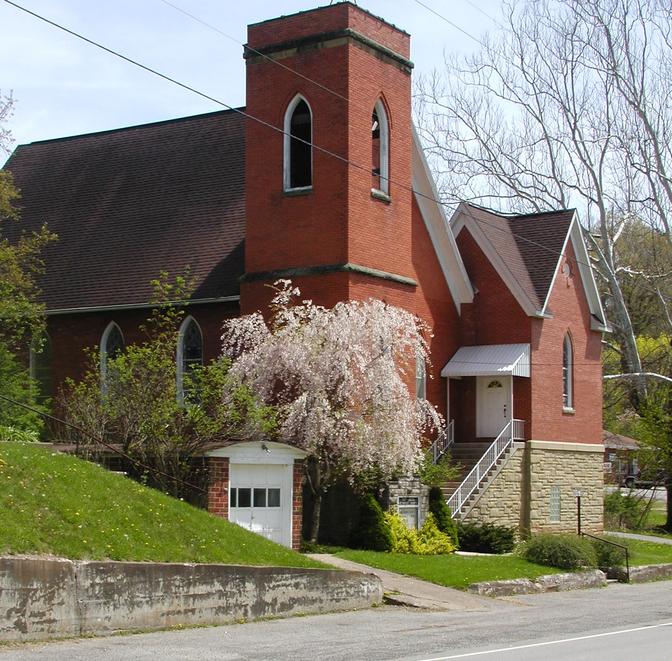
The family is descended from the Union Civil War General of the same name. The third Joe Lighburn was a politician of the right in a liberal era. He had great ability to influence and organize people, much to the distress of the local political forces. He was a man both ahead of, and behind the times, all at once. His views were not widely accepted, but he was a man of great integrity, a one who told the truth even when it was not popular. Let us reflect however, being on the right in 1985 involved very different, often opposite values from being on the right in 2000.
Next is the old People’s Bank, now the office for an advertising broadsheet. The large water tank in our basement came from it. The tank was sold to me by Walter Neely, who ran the hardware store behind the old bank for many years. It is the bank Uncle Gord put his money into after taking it out of the Lost Creek bank at the time of the Great Depression, to lose it.
(Illustration 59-12)
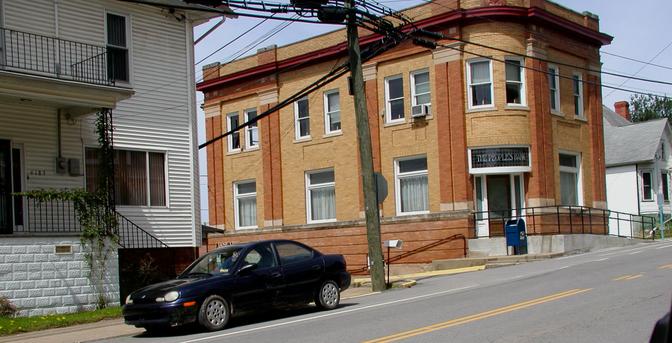
Before the “Great Depression” the Peoples Bank of Jane Lew, now Town Hall and a commercial building
Two blocks behind the bank is the glass factory, which has fed many in the community for decades. I remember visiting it at night with other kids when I was in high school. One remembers the fierce heat, the bulging cheeks of the glass blowers and the welcome we received, even late at night. No fear of mischief on the part of the factory people. The thing that keeps the glass factory alive today is the supply of skilled workers in the community.
Next, on the same side of Rt. 19, two doors down from the bank, is the building where Howard Neely, Walter’s father, ran a saloon before Prohibition. After Prohibition the Alcohol Beverage Control Comission (ABCC) law was instituted in West Virginia, and alcoholic beverages with more than 3.2% alcohol are sold through “state stores” and “clubs” established for that purpose.
Next are the offices of the Standard Gas Company, formerly also a bank – the vault is still visable to visitors to the office - and the community building where the Boy Scouts, 4-H club and other community groups meet.
Next to the river is Joe Lightburn IV’s store. It is a direct descendant of the old general store, not changed in philosophy or character or size, though it is built of concrete blocks. It was established in 1956 by his father, Joe Lightburn, III. You can buy almost anything useful to the home or farm. Older men still come to the local store to loaf and discuss things going on in the world. In the past there was discussion and opinion and thought in all stores. Now the news presented through the media is predigested right down to what your opinion should be. In public there is little discussion of anything that does not impinge directly on the pocketbook, schools excepted, and precious little discussion of pocketbook and school items. Neither churches, nor the local store, educate the population on issues. Today churches preach salvation in the abstract, without much consideration of good and evil and are afraid of politics. The big stores do not integrate the community, but simply and silently provide material goods.
We now are at the intersection of 19 and the I-79 access road in Jane Lew, and the end of the trip. Ahead to the left once stood the brick factory which produced brick and tile for use in the area from the clay bank further on to the left as you leave town going on toward Weston. It was a livelihood for many and a source of building materials well beyond the local community, but now it is gone, and is largely forgotten.
To the left, toward the interstate, is the powerhouse of Jane Lew today, the Volunteer Fire Department. It attracts able men and women who can organize, and others who have time to help. They raise money, buy equipment, train, and perform many kinds of community service. Putting out house fires is what one thinks of first, but they provide water where it is needed in quantities, pump out ponds, perform various kinds of rescue, including automobile accidents, and are first on the scene for accidents along the interstate. They perform temporary policing duty (accidents to trucks loaded with goods easily stolen, for example) and services attendant to chemical spills, and they clean blood and glass off highways after accidents.
The attraction in these volunteer fire departments, I believe, is the general sense of being helpful. It allows people with organizing skill to put these skills to work and people with leisure time to fill it with community service. There is a sense of excitement when the alarm goes off, and of fulfillment when you can tell others what happened at the scene. It must be source of pleasure to have the training, and to know what to do in an emergency.
The volunteer fire department works without explicit direction from above, doesn’t take a lot of taxes,
(Illustration 59-13)
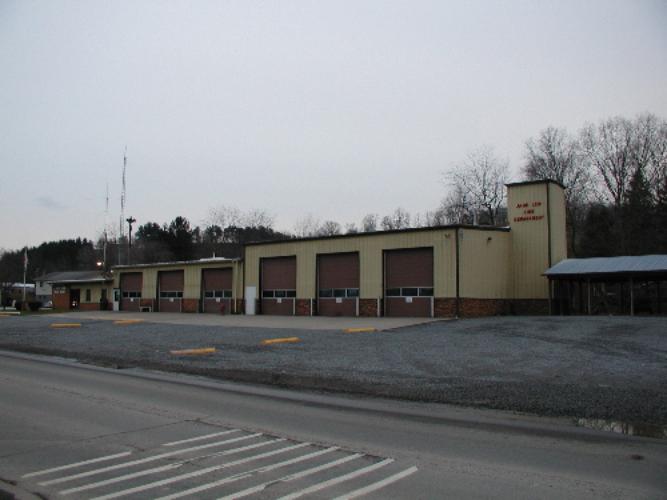
Jane Lew Volunteer Fire Department building
and makes people a part of something important. Institutions exist within government to regulate volunteer fire departments and provide appropriate training. As they exist today, volunteer fire departments are a fine institution. Their biggest problem is intrusion from higher levels of government, I hear. Jane Lew VFD, the one I am most familiar with, is a good one. Many other small towns have them. Lost Creek and West Milford I am less familiar with, but I know the same sort of service is provided by units in these towns.
Aside . One day when I was full grown a lady stopped her car at our house at Lost Creek and rushed up on the porch. Dad answered the door, and she told him that there was a crazy man in the cemetery half mile up the road mowing grass “perfectly naked.” Dad thought he was able to take care of it for her, so she went on. Dad went up to the cemetery, and sure enough, there was a man there mowing a lot. It was John Israel, mentioned at the beginning of the previous section, a long time family friend. He had removed his shirt, because it was hot, but he was wearing khaki pants, about the same color as his torso. They both had a good laugh. Dad told the family that “It must be a case of the woman seeing what she wanted to see, instead of what was there.” We were all glad she called Dad, rather than the Sheriff.
| Next Chapter | Previous Chapter | |
| Chapter 60: The Spankin Room | Contents | Chapter 58: Short Short Stories About Farmers |
Copyright © 1998, 2006, 2008, 2011 S. Tom Bond (stombond at hughes.net)